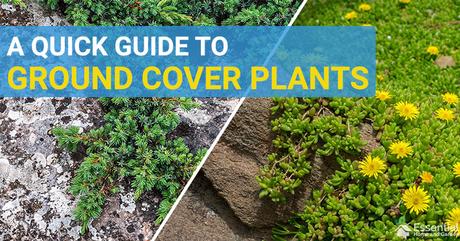
Many landscapers and gardeners struggle with filling blank spots in their gardens or property. Bare hillsides, exposed soil, and raw wall edges can all contribute to worsening the appearance of your garden or yard.
But adding ground cover plants can let you cover up these areas tastefully and even bring in some extra benefits at the same time.
What Defines a Ground Cover Plant?
Ground cover plants do exactly what their name suggests: cover the ground. Landscapers and homeowners use these plants to fill their grounds with aesthetically tasteful and low maintenance shrubs and flowers.
While most ground cover plants are short and close to the ground, they're defined not by their height but by their function. Ground cover plants form interconnected mats of greenery and color that slowly creep out around their designated area.
Although they're similar, ground cover plants are not the same things as cover crops. Cover crops are normally used for mulching purposes in vegetable gardens or large-scale food production. They help add nutrients to the soil and promote healthy growth for other plants.
When To Use Ground Cover Plants in Landscaping?
There are lots of reasons that you might decide to use ground covers for your landscaping or gardening project.
Weed Choking
Ground cover plants can be excellent weed chokers if you pick the right species. The creeping, spreading nature of ground cover plants help block out weeds from receiving sunlight, preventing weed infestations from taking hold of your green space.
Adding Fragrance
Ground cover plants can also add a nice fragrance to your grounds. Species like mint or thyme can creep into the surrounding area and lend an interesting olfactory aura to your home or garden.
Covering Slopes
Slopes can be hard to mow or trim, so you can use ground cover plants to decorate those slopes and hills without resorting to regular grass. This way, you don't have to ignore a boring, uncovered hill in your yard.
Fill Holes in Your Yard
Ground cover plants can also provide aesthetic appeal in places that are too hot or too shaded for regular turf grasses. Ground cover plants designed for life in arid or shady environments can thrive and spread where grass would normally wilt.
Overall, the only limit to the use of ground cover plants is your imagination.
Our Favorite Ground Cover Plants
These are some of the best ground cover plant species.
Thyme (Thymus serpyllum 'Albus')
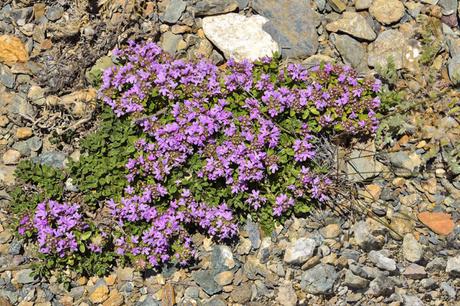
Originally from Eurasia, Creeping Thyme is an excellent ground cover plant for sunny spaces and moderate climates. Most varieties of this groundcover plant are low and vine-like. Creeping Thyme produces a light aroma that's floral and herbal in nature. During the spring and summer, the Thyme will sprout with colorful buds all across its top layer.
Due to their wide, thin spreading pattern, Creeping Thyme is well-used as a filler plant between stepping stones or between bushes and bigger plants. It's also acceptable for use as an edging plant.
Finally, some varieties of Creeping Thyme can be harvested either as a culinary herb or a medicinal plant depending on your needs and experience. Thyme can be added to meals in either fresh or dry varieties and is a well-known antiseptic.
Korean Rock Fern (Polystichum tsus-simense)
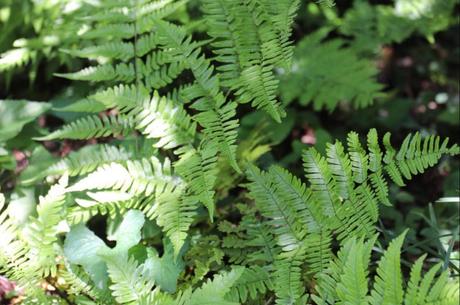
This fern features dark green fronds that can mix or contrast well with various species of grass or other plants in your garden and yard. It can survive well in shady areas, making it an excellent ground cover replacement for areas in your yard where regular grass won't get enough sunlight.
Korean Rock Fern grows very quickly and can easily reach up to 12 inches tall and wide. Further extensions are not uncommon. Covering a wide surface area with only a few plants is very possible.
Because they can survive well in the shade, these firms are well-suited to edging along the walls of your garden. They're deer-resistant, so they're one of the best ground cover plants if you live in a temperate forest climate.
Creeping Juniper (Juniperus horizontalis)
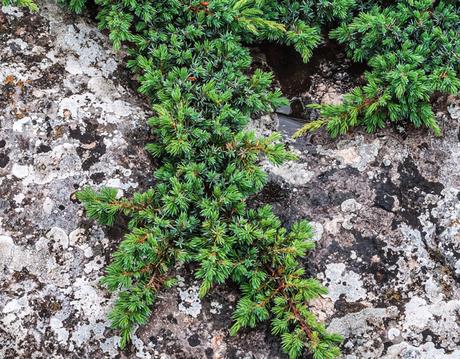
This evergreen shrub grows very low to the ground but has horizontally extending plume branches. This allows it to spread over a wide surface area very quickly.
Creeping Juniper plants differ based on their sexes; female junipers grow berries that can be harvested or left alone, although the berries are not very bright or decorative. Both male and female plants will look blue or green in the spring and summer and slowly turned to a plum color near winter.
Creeping Juniper is one of the best ground cover plants for adding to slopes and hillsides, as its wide surface area coverage reduces the amount you need to plant for effective coverage.
Creeping Juniper also helps prevent soil erosion and can survive in hot or dry conditions. Planting juniper near sidewalks and walls is also effective, as these areas are sometimes drier than surrounding soils.
Sedum (Stonecrop)
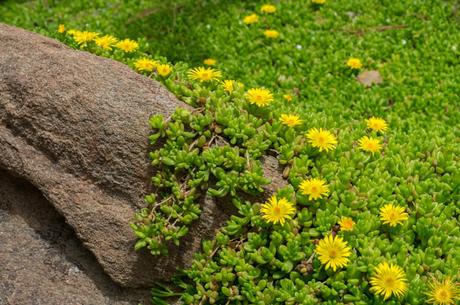
Sedum (also called stonecrop) is a hardy succulent plant that can thrive in the cracks of stone walls and the creases of your garden constructs. They're an excellent choice if you'd like to cover more ground around your walls or wells where regular grass may retreat.
Sedum come in over 400 species and the leaves range from green to blue-gray to red or bronze depending on the season and water level. They will sometimes turn red in the winter.
Creeping Sedum doesn't require particularly nourishing soil to grow and spread. They do suffer from too much water in the soil, however, so they are ideal for hot or dry climates. Sedum requires enough drainage in its environment so that its host soil doesn't become too choked with moisture.
Basket of Gold (Aurinia saxatilis)

This ground cover plant is an evergreen perennial. It usually boasts golden yellow flowers in the spring, making it an excellent accessory to gardens with lots of vibrant hues already. Basket of Gold is drought tolerant and prefers being planted in spots with plenty of sunlight.
In addition, Basket of Gold can easily draw in insect colonies due to the abundance of vector included in its flower buds. Therefore, adding Basket of Gold your garden can bootstrap more helpful insect pollination and other activity if needed.
